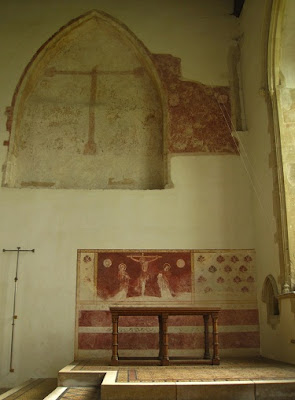On the way to pick up Jules, Dru and I stopped off at Uffington to see if we could get a better glimpse of the prehistoric White Horse than last time, which we did. However, we decided that we still need to get better acquainted with it, so a walk to it and to the neolithic long barrow at nearby Wayland's Smithy looks to be in the offing over the next few months.
Once reunited with Joolz and refreshed with coffee and pies, Dorchester Abbey was our first port of call, and in case you're thinking hang on, Dorchester isn't in Oxfordshire either, it's situated in Dorchester-on-Thames. So, no Thomas Hardy heritage trails or memorial tea shops, though it was all very picturesque.
 Dorchester Abbey is the former Abbey Church and is full of beautiful things. There's the entrance door for a start, with its spectacular hinges.
Dorchester Abbey is the former Abbey Church and is full of beautiful things. There's the entrance door for a start, with its spectacular hinges.  And the lead font of 1140, which is carved with images of the apostles (barring Judas) and is apparently the only such font from a monastic Church to have survived the Dissolution of the Monasteries.
And the lead font of 1140, which is carved with images of the apostles (barring Judas) and is apparently the only such font from a monastic Church to have survived the Dissolution of the Monasteries.  Also surviving are these beautiful raspberry-coloured murals of 1340 in the People's Chapel. In fact, Dorchester's Abbey Church seems to have emerged from the Reformation remarkably unscathed. For this we need to be grateful to a local worthy, Sir Richard Bewfforeste, who paid King Henry VIII the value of the lead roof (the huge sum of £140), thus saving the Church for the local community to use.
Also surviving are these beautiful raspberry-coloured murals of 1340 in the People's Chapel. In fact, Dorchester's Abbey Church seems to have emerged from the Reformation remarkably unscathed. For this we need to be grateful to a local worthy, Sir Richard Bewfforeste, who paid King Henry VIII the value of the lead roof (the huge sum of £140), thus saving the Church for the local community to use.  I also LOVED the Tree of Jesse window, another survival from 1340 and here seen from the outside because ... it looks like a tree! Genius!
I also LOVED the Tree of Jesse window, another survival from 1340 and here seen from the outside because ... it looks like a tree! Genius!  Can't possibly describe everything there was to marvel at, although I can't not mention the gravestone of poor Sarah Fletcher who hanged herself in 1799, after turning up at and putting a stop to the bigamous marriage of her husband to a wealthy heiress. She is buried in the nave, unusually for a suicide, and the cause of her death is given as 'excessive sensibility'.
Can't possibly describe everything there was to marvel at, although I can't not mention the gravestone of poor Sarah Fletcher who hanged herself in 1799, after turning up at and putting a stop to the bigamous marriage of her husband to a wealthy heiress. She is buried in the nave, unusually for a suicide, and the cause of her death is given as 'excessive sensibility'. (And just look at the beautiful mediaeval tiles next to her. Some solace, surely.)
On our way to Buscot we detoured to pick some sloes (for sloe gin, naturally) and blackberries - these to add to the crab apples Dru and I had scrabbled after in the road near the White Horse. Hasn't been a good fruiting year this year, so we have to make the most of what we can get our hands on.
 Buscot was exactly how I'd imagined and not my cup of tea at all, but for the Burne Jones murals depicting the Legend of the Briar Rose in the saloon. (These, of course, are why we'd gone there.) The rest of the room was horrid - it had the most tasteless chandelier I think I've ever seen, and nasty, uncomfortable-looking furniture - but they were sublime, if poorly lit.
Buscot was exactly how I'd imagined and not my cup of tea at all, but for the Burne Jones murals depicting the Legend of the Briar Rose in the saloon. (These, of course, are why we'd gone there.) The rest of the room was horrid - it had the most tasteless chandelier I think I've ever seen, and nasty, uncomfortable-looking furniture - but they were sublime, if poorly lit. Had to feel a bit sorry for Burne Jones, and Morris, who penned some poetry to accompany the paintings, who would have had to see their work in such unsympathetic surroundings.
There was a catholic collection of art, some parts of which I liked a lot, and the walled garden was beautiful although I can't say I'm a fan of landscape gardens.
The opulence was just overwhelming, which made the following fresco in the swimming pool pavilion all the more surprising. For it turns out that 2nd Baron Faringdon was a Labour MP. Known for his 'effeminate demeanour', he once opened a debate in the House of Lords by saying 'my dears' instead of 'my Lords'. As if that wasn't enough to make you love him, he served in a field hospital in Aragon during the Spanish Civil War, later giving a home to 40 Spanish child-evacuees and other exiles. A pacifist, he saw service in the London Fire Brigade during the second world war.
On the way home, Dru and I realised that we'd omitted to visit the Church in the village of Buscot, the east window of which was designed by Burne Jones (yes, him again). But as it's close to Uffington, we can doubtless pop in on our next jaunt.
Thanks to Dru and Jules for their company on such a wonderful day out.















































